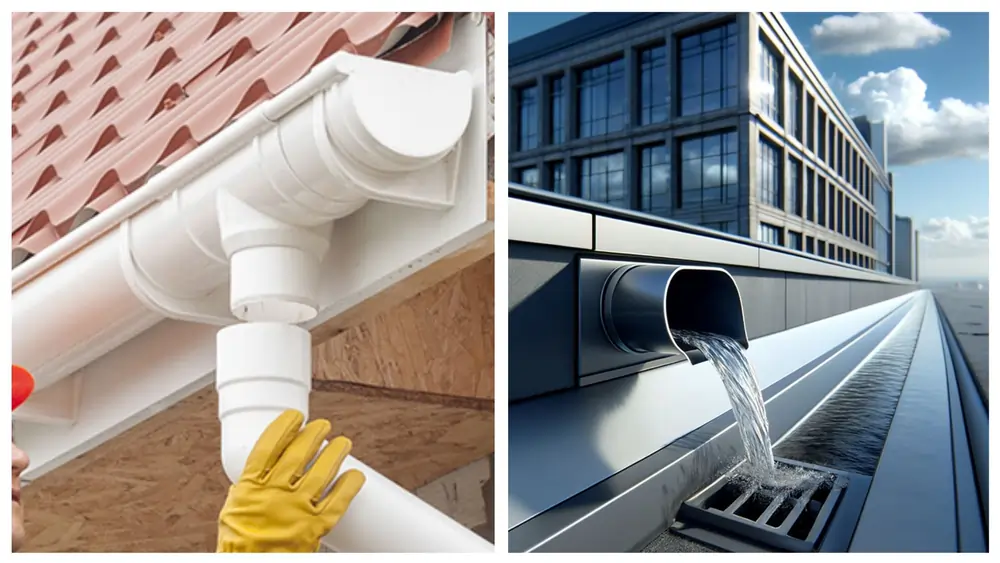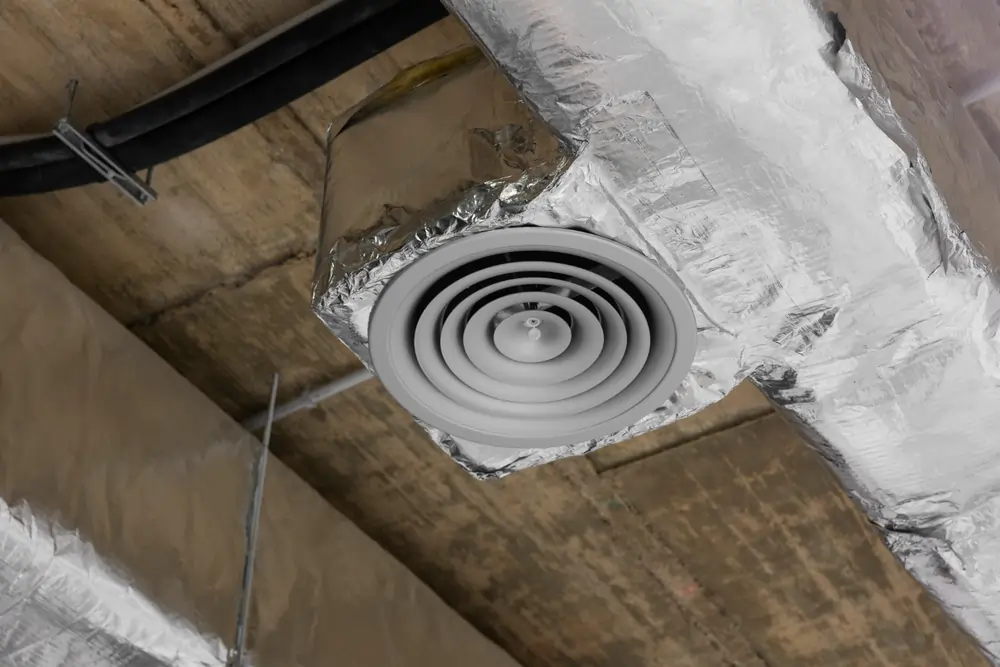Is your home at risk of water damage? You might not realize it, but your roof drainage system plays a crucial role in protecting your property. Without proper drainage, you could face costly repairs, mold growth, and even structural damage. But don’t worry – we’ve got you covered with this comprehensive guide to roof drainage systems in 2024.
Roof Drainage System
When it comes to protecting your home from water damage, a roof drainage system is an absolute game-changer! Did you know that improper drainage is one of the leading causes of structural damage in buildings? I’ve seen this firsthand with houses in rainy climates where poor drainage leads to mold, leaks, and even foundation issues. In this guide, we’re diving deep into the world of roof drainage systems—what they are, why they matter, and how to choose the right one for your home or business. Whether you’re building a new roof or upgrading an old one, you’ll learn everything from types of drainage systems to essential maintenance tips.
What Is a Roof Drainage System?
A roof drainage system is a network of components designed to channel water away from your roof and foundation. It’s your home’s first line of defense against water damage, working tirelessly to protect your investment.
Definition and purpose of a roof drainage system

The primary purpose of a roof drainage system is to manage rainwater effectively. It collects water from your roof’s surface and directs it away from your home’s foundation. This simple yet crucial function prevents a host of potential problems.
Importance of proper drainage for structural integrity
Without adequate drainage, water can pool on your roof or seep into your home’s structure. This can lead to:
- Roof leaks
- Wood rot
- Foundation cracks
- Mold growth
- Soil erosion around your home
But here’s the kicker: many homeowners don’t realize they have a drainage problem until it’s too late. By then, the damage can be extensive and expensive to repair.
How roof drainage systems work
Roof drainage systems work on a simple principle: gravity. They use a combination of slopes, channels, and pipes to guide water down and away from your home. But the specifics can vary depending on your roof type and local climate.
Common problems caused by poor drainage
Imagine waking up to find your ceiling dripping or your basement flooded. These are just a few of the issues that can arise from inadequate roof drainage. But what if there was a way to prevent these problems before they start?
Types of Roof Drainage Systems
When it comes to commercial roof drainage systems, there are several types to consider. A typical gutter system with downspouts is common, but building owners might also opt for interior drains or siphonic roof drains. These systems help drain off the roof and prevent standing water.
For low slope roofs on commercial buildings, a siphonic drainage system can be highly effective. It uses a special piping system to quickly move water from the roof to the underground drainage. This ensures that water on the roof is removed efficiently, preventing any overflow issues.
Scupper drains are another option, typically placed at the edge of the roof. They help direct water to the side of the building and into a downspout. A roofing professional can help determine the best roof’s drainage system based on the roof surface and building codes.
Not all roof drainage systems are created equal. Let’s explore the most common types and their unique benefits.
Overview of the most common systems

- Gutters: These are the most familiar type of drainage system. They collect water at the roof’s edge and channel it to downspouts.
- Downspouts: These vertical pipes carry water from the gutters to the ground level.
- Internal drains: Common in flat roof drainage systems, these drains are installed within the roof itself.
- Roof scuppers: These are openings in the roof’s edge or parapet walls that allow water to drain off.
Pros and cons of each system
Each system has its strengths and weaknesses. For example, gutters are effective for most homes but can clog with debris. Internal drains are great for flat roofs but require regular maintenance to prevent blockages.
Best applications for different climates and roof designs
Your local climate and roof design play a significant role in choosing the right system. Flat roof drainage requires different solutions than sloped roofs. In areas with heavy rainfall, a combination of systems might be necessary.
Components of a Roof Drainage System
Alright, let’s talk about the importance of a roof drainage system. A residential roof needs a proper drainage system to prevent water from pooling. The slope of the roof helps drain water efficiently, and stainless steel roof drains are a solid choice for durability.
When installing roof drains, it’s crucial to ensure that the drains are positioned correctly to cover the entire roof and drainage area. A professional roof installer or roofer can help with this. The drain system beneath the roof collects water and diverts it outside of the building.
For pitched roofs, siphonic drain systems work wonders to move water quickly. The drains to collect water are essential to avoid ponding water and potential damage. Knowing everything you need to know about your local building codes will ensure your roof may meet all requirements.
A roof drainage system is more than just gutters and downspouts. Let’s break down the key components that make these systems work efficiently.
Key elements to consider
- Gutter guards: These prevent leaves and debris from clogging your gutters.
- Leaf strainers: Installed at the top of downspouts, they catch larger debris.
- Splash blocks: These divert water away from your foundation at ground level.
- Drainage pipes: Underground pipes that carry water away from your home.
How each component contributes to the system’s efficiency

Each component plays a crucial role in the overall effectiveness of your drainage system. For instance, gutter guards can significantly reduce the need for cleaning and maintenance.
Material choices and durability considerations
From aluminum to copper, the material you choose for your roof drainage system can impact its longevity and performance. But which material offers the best value for your investment?
How to Choose the Right Roof Drainage System
Choosing the right drains and drainage system for your roof is key to keeping your property dry and safe. First, consider the area of the roof you need to cover. Different roofing materials and types of flat roofs require specific solutions to effectively divert water.
For residential or commercial buildings, you want a system that prevents leaks and water damage. Make sure your drain is designed to keep debris from entering and clogging up the works. In the case of a clog, water can back up and cause issues, especially if water may freeze in colder climates.
Don’t forget to check your downspouts and downspouts and gutters to ensure they are clear and allowing the flow of water away from the building. Scuppers are popular for flat roofs and can help keep water away from doors and windows. Consider your landscape and how water will be entering the system and exiting it.
Selecting the right system for your home isn’t just about aesthetics. It’s a decision that can impact your home’s integrity for years to come.
Factors to consider
- Climate and weather patterns: Areas with heavy rainfall or snow require more robust systems.
- Roof size and slope: The pitch of your roof affects how quickly water drains.
- Building structure and location: Your home’s design and surroundings play a role in drainage needs.
Budget considerations for installation and long-term maintenance
While it might be tempting to cut corners to save money, investing in a quality roof drainage system can save you thousands in potential repair costs down the line.
Professional installation vs. DIY
Can you install a roof drainage system yourself, or should you call in the pros? We’ll weigh the pros and cons to help you make an informed decision.
Maintenance Tips for Roof Drainage Systems
Hey, keeping your roof in tip-top shape is key! Make sure your roof to divert water is clear of leaves and debris. This helps allow the water to flow smoothly. When water simply can’t drain, it can cause leaks. Remember, atmospheric pressure can also affect drainage efficiency. Happy cleaning!
Proper maintenance is key to ensuring your roof drainage system continues to protect your home year after year.
Why regular maintenance is crucial
Regular maintenance prevents small issues from becoming major problems. It can extend the life of your system and save you money in the long run.
Seasonal maintenance tasks
- Cleaning gutters and downspouts: Remove leaves and debris regularly.
- Inspecting for blockages or leaks: Check for proper water flow and signs of damage.
- Checking for wear and tear on components: Look for rust, cracks, or loose fittings.
Signs it’s time to repair or replace your system
How do you know when it’s time to upgrade your drainage system? We’ll cover the warning signs that indicate your system might be failing.
Innovative Roof Drainage Solutions for 2024
The world of roof drainage is evolving. Let’s explore some cutting-edge solutions that are changing the game.
Trends in roof drainage technology
From smart drainage systems with sensors to eco-friendly materials, new technologies are making drainage systems more efficient than ever.
Sustainable and eco-friendly drainage systems
Rainwater harvesting systems are gaining popularity, allowing homeowners to collect and reuse rainwater for irrigation and other purposes.
Smart drainage systems: sensors and automated maintenance
Imagine a system that could alert you to clogs or leaks before they become major issues. That future is closer than you might think.
Benefits of upgrading to newer systems
Upgrading your roof drainage system can improve your home’s efficiency, reduce maintenance needs, and even increase its value.
Conclusion
At the end of the day, investing in a quality roof drainage system is one of the best ways to protect your home from the elements. Whether you’re dealing with heavy rain or just want to avoid the hassle of constant repairs, understanding your options and keeping your system maintained will save you time, money, and headaches. So, take a look at your current setup, and don’t hesitate to consult with a professional if you’re unsure which system is right for you. Ready to take the next step? Explore the latest drainage systems available in 2024 and give your roof the upgrade it deserves!
A well-designed and maintained roof drainage system is essential for protecting your home from water damage. By understanding the different types of systems, their components, and how to maintain them, you can ensure your home stays dry and secure for years to come.
But there’s still so much more to learn about roof drainage systems. Are you ready to dive deeper into this crucial aspect of home maintenance?

